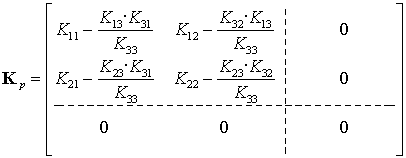Ecole des Mines de Nantes, 4 rue Alfred-Kastler, Nantes 44307, France
Institut de Recherches en Communications et en Cybernetique de Nantes, 1 rue de la Noe, 44321 Nantes, France
(Submmited to "IEEE Transactions on Robotics", 2011)
Previous page | Outline | Next page
Let us present first a simple example that demonstrates non-trivial transformation of the stiffness matrix due to the presence of passive joints. For the purpose of simplicity, let us limit our study to 2D Cartesian space and consider a single manipulator link, which is assumed to be fixed at the one end. It is also assumed that the external loading (the forces ![]() and the torque
and the torque ![]() ) is applied to another end; either directly or through a passive joint.
) is applied to another end; either directly or through a passive joint.
Under these assumptions, the elastostatic properties of the link can be described by a symmetrical stiffness matrix ![]() of size
of size ![]() and its potential energy due to elastic deformations (linear deflections
and its potential energy due to elastic deformations (linear deflections ![]() and angular deflection
and angular deflection ![]() ) may be expressed as
) may be expressed as
 |
(1) |
If the link is equipped with a passive joint, the energy of this mechanical system (link with passive joint) must be minimised with respect to the joint variable4. For instance, in the case of the rotational passive joint ![]() allowing free rotation around the z-axis at the reference point, the potential energy should be rewritten as
allowing free rotation around the z-axis at the reference point, the potential energy should be rewritten as
(2) |
and the passive joint variable ![]() may be expressed via the remaining coordinates as
may be expressed via the remaining coordinates as ![]() . Then, after relevant transformations and computations of the second-order derivatives (i.e. the Hessian of
. Then, after relevant transformations and computations of the second-order derivatives (i.e. the Hessian of ![]() with respect to x, y and
with respect to x, y and ![]() )
)
(3) |
the desired stiffness matrix of links with passive joint may be expressed as
 |
(4) |
This expression clearly shows that, if the matrix ![]() is non-diagonal, a trivial transformation that was proposed in some previous works (i.e., simple setting to zero of the third row and column) does not produce a truthful result. Moreover, the elements of the upper-left
is non-diagonal, a trivial transformation that was proposed in some previous works (i.e., simple setting to zero of the third row and column) does not produce a truthful result. Moreover, the elements of the upper-left ![]() block must be modified taking into account the elements of
block must be modified taking into account the elements of ![]() that are located outside of this block. Similar results corresponding to other types of passive joints are summarized in Table 1, where they are also applied to classical 2D beam (in this case, some elements of the
that are located outside of this block. Similar results corresponding to other types of passive joints are summarized in Table 1, where they are also applied to classical 2D beam (in this case, some elements of the ![]() are four times lower compared to
are four times lower compared to ![]() ). This conclusion motivates development of a general methodology of the stiffness matrix transformation, which is presented below.
). This conclusion motivates development of a general methodology of the stiffness matrix transformation, which is presented below.
Table I
Transformation of the link stiffness matrix due to passive joints (2D case)
